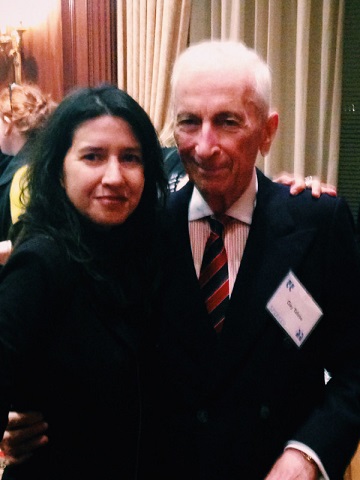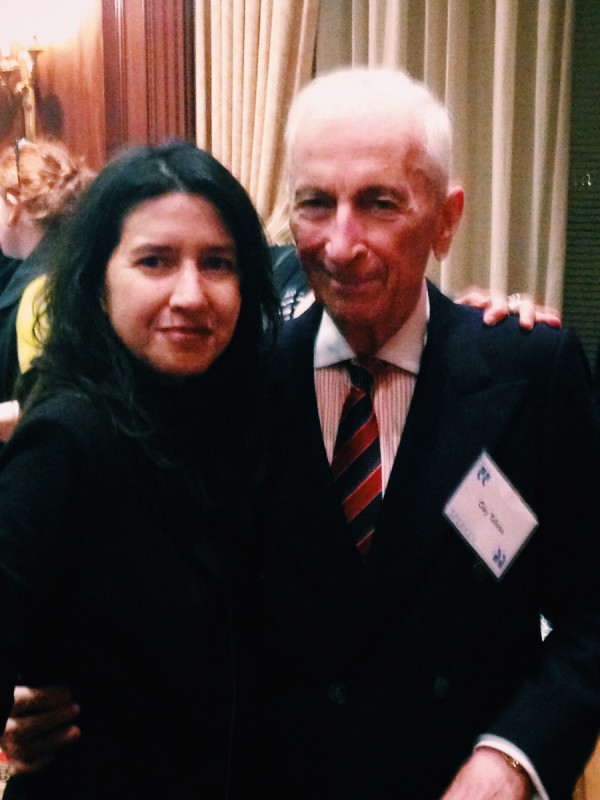
Gay Talese stood alone in the middle of the crowded salon. He reached into his coat pocket for the “note cards” which he famously cuts from shirt boards. Talese, it was clear, had been taking notes. He shuffled them and stuffed them back, then pivoted and walked toward the bookcase. I tracked his progress, waiting for the right moment to make my move.
Talese is revered as the godfather of New Journalism and a master in the craft of narrative journalism. His legendary 1966 Esquire profile, “Frank Sinatra Has a Cold,” is, for the aspiring writer, the equivalent to the chord progression of Stairway to Heaven. And just a few hours earlier, he had managed to alienate quite a few journalists at Boston University’s Power of Narrative conference after he said he couldn’t name one female writer who had inspired him.
But Talese went further in responding to a question posed by poet and invited speaker Verandah Porche, saying that “educated women, writerly women don’t want to, or do not feel comfortable dealing with strangers,” or for that matter, he continued, the uneducated, the mobsters, the voyeurs and porn stars—the sort of unsavory characters who have fascinated him and his readers.
The barest silence followed before Sandy Tolan, veteran journalist and professor at the University of Southern California’s Annenberg School for Communication and Journalism, shouted, “Joan Didion?” Talese acknowledged Didion, whose “Slouching Toward Bethlehem” is the writer’s “Purple Haze,” as brilliant before dismissing her as another writerly woman with a preference for the educated.
Women began streaming out of the auditorium and I joined them, not so much in angry protest as a sense that listening on was unnecessary.
Later, in an email to the Boston Globe, Talese wrote that he understood the question to mean his inspirations as a young man. Back then, he said, newswomen were largely consigned to the society pages, gardening and such. He then ticked off the names of contemporary female writers whom he admires.
In the auditorium, however, the distinction between past and present was imperceptible. His initial answer seemed to describe women of a previous era, but, as he went on, his comments lost any sense of a time stamp. Women began streaming out of the auditorium and I joined them, not so much in angry protest as a sense that listening on was unnecessary.
But now Talese moved through the private party for conference speakers. He was among the headlining acts and I was a first-time invited speaker. I handed my phone to another writer and asked her to take photos. However things turned out, it would end with dignity and I would pose with the man. Talese reached for his fedora, which was nestled on top of a stack of books, and I seized his arm.
“Mr. Talese,” I said, before introducing myself and explaining that I had reported from Mexico after President Felipe Calderon launched his so-called “drug war,” in which over 100,000 people have died and tens of thousands more have disappeared. I quickly went through my career highlights with misfits, criminals, and the outcast, on both sides of the border. But had I interviewed a voyeur, he wanted to know.
Not yet, I told him, but I did once tag along with a film crew shooting a narco flick in Tijuana while we looked for prostitutes in the early morning. And I hadn’t had any coffee yet. I suggested that we might take a photograph, “So you could remember that you met me.” His eyes shifted down and then back up and he said, “Well yes, you’re a sexy woman.” We turned, she clicked.
Talese, upon learning where she worked, began grilling her about she landed such a plum job, who had hired her and why.
Talese was going to another bar. Was I alone? “Not until you came along,” I replied. I had made my point and now he was making his. Experience has taught me that the scales are balanced at the writing desk. Talese said he wouldn’t wait, and I assured him I could catch up. I spent a moment rounding up the other speakers from the race and identity panel, to descend on Talese with me as a group, but that idea quickly grew to seem silly. Food and drink aside, we were vastly more interested in our own conversation.
I was soon comparing notes with Nikole Hannah-Jones, a writer with The New York Times Magazine who had delivered the opening keynote address. Talese, upon learning where she worked, began grilling her about she landed such a plum job, who had hired her and why. At one point, he asked if she was off to have her nails done. Details of her experience later appeared in Slate and The New York Times.
Hannah-Jones, who is black, shared the story with me and another Latina journalist. The racial element was impossible to overlook; indeed it was indicative. To me, Talese’s statement on gender followed his more subtle statement on race—all of the writers and performers he had cited were not only male, they were also all white.
Details of the Talese incident soon began circulating along with the cocktails. One journalist suggested that I tweet the series of photos, along a description of what happened. I considered posting a synopsis on Facebook but decided to wait, feeling I had overlooked something.
I had gone wrong by meeting him within his paradigm, one built by men, white men, with their perspective at its center.
Just before I delivered my own talk I realized my mistake. I had confronted Talese because I didn’t want the younger journalists at the conference to think that we, who had the experience, had folded our arms and said nothing. Verandah Porche later told me that she had asked Talese the question because she felt a responsibility to challenge him, as a woman and a peer of roughly the same generation.
But I had gone wrong by meeting him within his paradigm, one built by men, white men, with their perspective at its center. Talese earned his stature as a craftsman, I said in my remarks, but also came to it because he helped replicate well-worn myths about this country, its pioneers, misfits, and shady characters worthy of our attention, a sensibility intrinsically connected to race and gender.
And I had succumbed to that sensibility myself. I met his bragging points with examples—of a border region and Mexico—that fit within the well-entrenched myth created by and for white men. I had mentioned shady characters, but not the fathers in Ciudad Juarez who overcame enormous odds to search for their missing children, or the women who have confronted political leaders, including the president, over criminal impunity, or the heroic journalists in Mexico who taught me much about commitment, honor and courage.
In the days since, Sandy Tolan, who attended my talk, suggested that I had been too hard on myself, that perhaps I had attempted to meet him “at a place he understood, speaking his language, in an effort to make a point he’d understand.” And that’s when I realized that in approaching Talese, I had sought to claim a space in the center of perspective. If only for me. My examples, while imperfect, to my mind communicated a point—perspectives such as his are now understood as relative, just another genre.
Michelle García is a writer, radio reporter, and video journalist whose work has appeared in the Oxford American, the Washington Post, Salon, and numerous other media outlets. She is the producer and director of the PBS documentary Against Mexico: The Making of Heroes and Enemies and is traveling the US-Mexico border working on a book about the border, myth, and masculinity. Find her at www.michellegarciainc.com and on twitter at @pistoleraprod.
